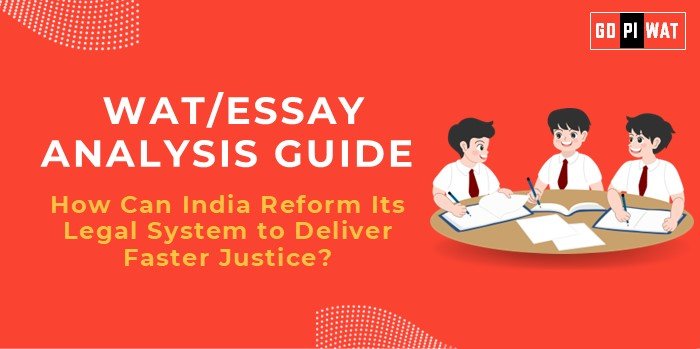📋 Written Ability Test (WAT)/Essay Analysis Guide: How Can India Reform Its Legal System to Deliver Faster Justice?
🌐 Understanding the Topic’s Importance
Context Statement: Faster justice delivery is critical for upholding the rule of law, protecting rights, and ensuring societal trust in the judiciary, making it a cornerstone of democratic governance.
⏳ Effective Planning and Writing
- Time Allocation:
- 📝 Planning: 5 minutes
- ✍️ Writing: 20 minutes
- 🔍 Review: 5 minutes
- Preparation Tips: Research key reforms (e.g., e-Courts), collect recent statistics, and outline systemic challenges.
💡 Introduction Techniques for Essays
-
- Contrast Approach:
“While India prides itself on a robust judiciary, the case backlog exceeding 40 million underscores its inefficiencies.”
-
- Solution-Based:
“Reforms like e-Courts and ADR systems are pivotal to transforming India’s judiciary into a model of efficiency and inclusivity.”
📖 Structuring the Essay Body
- Achievements:
- ✅ Highlight digitization via e-Courts and transparency improvements.
- 🤝 Lok Adalats’ success in dispute resolution.
- ⚖️ Transformative judgments that streamline justice processes.
- Challenges with Comparative Analysis:
- ⚠️ Resource gaps and judicial staffing shortages.
- 🌍 Contrast India’s backlog with Singapore’s AI-aided judiciary efficiency.
- Future Outlook:
- 📜 Scaling ADR mechanisms like mediation and arbitration.
- 📈 Boosting judicial strength by recruiting more judges.
- 🤖 Leveraging AI for case management and predictive analytics.
📄 Concluding Effectively
-
- Balanced Perspective:
“India’s judicial reforms are a promising start, but systemic changes in staffing, infrastructure, and procedural law are essential for enduring results.”
-
- Global Comparison:
“Drawing lessons from nations like Singapore can guide India’s path towards an efficient and equitable legal system.”
📊 Analyzing Successes and Shortcomings
- Achievements:
- ✅ Enhanced transparency through digitization initiatives.
- 🤝 Faster dispute resolution via ADR mechanisms like mediation.
- Challenges:
- ⚠️ Resource gaps in staffing and infrastructure.
- 📘 Digital literacy divide among stakeholders.
- Global Context: Singapore and the US serve as benchmarks for reforms in efficiency and ADR success.
🚀 Recommendations for Sustainable Progress
- 👩⚖️ Increase Judge Strength: Implement the recommendations of the 245th Law Commission Report.
- 🤝 Expand ADR Mechanisms: Promote mediation and arbitration to ease the burden on courts.
- 🤖 Adopt AI: Use predictive analytics for efficient case management and prioritization.
✍️ Sample Short Essays
-
- Balanced Perspective:
“India’s judicial system is a blend of achievements and challenges. While reforms like e-Courts are commendable, addressing structural bottlenecks is critical for delivering timely justice.”
-
- Solution-Oriented:
“Technology, ADR mechanisms, and better resource allocation can transform India’s judiciary into a model of efficiency and equity.”
-
- Global Comparison:
“Learning from Singapore’s AI-based systems and the US’s ADR success can inspire scalable solutions for India’s judiciary.”


